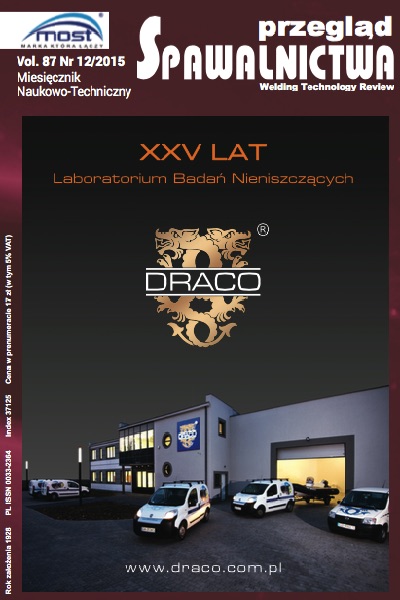Lokalizacja tomografem ultradźwiękowym miejsca na granicy ośrodków o różnej gęstości w elemencie betonowym
Main Article Content
Abstract
W artykule przedstawiono zastosowanie tomografu ultradźwiękowego do lokalizacji miejsca na granicy ośrodków o różnej gęstości w elemencie betonowym dostępnym z jednej strony. Dla czytelności artykułu przedstawiono najważniejsze zagadnienia związane z propagacją fal mechanicznych. Wykonano obliczenia numeryczne MES w programie ABAQUS dla zamodelowanego elementu betonowego. Na podstawie tych obliczeń pokazano możliwość lokalizacji miejsca na granicy ośrodków o różnej gęstości umieszczonych w elemencie betonowym dostępnym z jednej strony. Następnie wykonano badania nieniszczące z wykorzystaniem tomografu ultradźwiękowego, na podstawie których zlokalizowano miejsce na granicy ośrodków o rożnej gęstości i tym samym potwierdzono możliwość wykonania takiej lokalizacji przy pomocy tomografu ultradźwiękowego oraz prawidłowość opracowanego modelu numerycznego.
Localization of the place on the border between mediums of different density using ultrasonic tomography
The article describes the use of an ultrasound scanner to locate the place on the border between mediums of different density in the concrete element. For clarity, the article presents the most important issues related to the propagation of mechanical waves. The first step FEM numerical calculations in ABAQUS program were performed. The possibility to locate points from the boundaries of different density disposed in the concrete element are shown on the basis of these calculations. Next, a non-destructive testing with use of ultrasonic tomography, which were used to locate the boundaries of different density and thus confirmed the possibility to find such a location using ultrasonic tomography and the correctness of the numerical model developed.
Downloads
Article Details
Creative Commons CC BY 4.0 https://creativecommons.org/licenses/by/4.0/
Welding Technology Review (WTR) articles are published open access under a CC BY licence (Creative Commons Attribution 4.0 International licence). The CC BY licence is the most open licence available and considered the industry 'gold standard' for open access; it is also preferred by many funders. This licence allows readers to copy and redistribute the material in any medium or format, and to alter, transform, or build upon the material, including for commercial use, providing the original author is credited.
References
J. Hoła, K. Schabowicz, State-of-the-art non-destructive methods for diagnostic testing of building structures anticipated development trends, Arch. Civ. Mech. Eng., t. 10, nr 3, ss. 518, 2010.
K. Schabowicz, Ultrasonic tomography The latest nondestructive techni- que for testing concrete members Description, test methodology, applica- tion example, Arch. Civ. Mech. Eng., t. 14, nr 2, ss. 295303, Luty 2014.
K. Schabowicz i V. A. Suvorov, Nondestructive testing of a bottom sur- face and construction of its profile by ultrasonic tomography, Russ. J. Nondestruct. Test., t. 50, nr 2, ss. 109119, luty 2014.
A. O. De La Haza, A. A. Samokrutov, i P. A. Samokrutov, Assessment of concrete structures using the Mira and Eyecon ultrasonic shear wave devices and the SAFT-C image reconstruction technique, Constr. Build. Mater., t. 38, ss. 12761291, Stycze 2013.
A. J. Chorin i A. J. Majda, Red., Wave Motion: Theory, Modelling, and Computation, t. 7. New York, NY: Springer US, 1987.
L. Lam i H. C. Morris, Red., Wave Phenomena. New York, NY: Springer New York, 1989.
Wave Physics. Berlin, Heidelberg: Springer Berlin Heidelberg, 2009.
J. Krautkrämer, H. Krautkrämer, Ultrasonic Testing of Materials. Berlin, Heidelberg: Springer Berlin Heidelberg, 1983.
